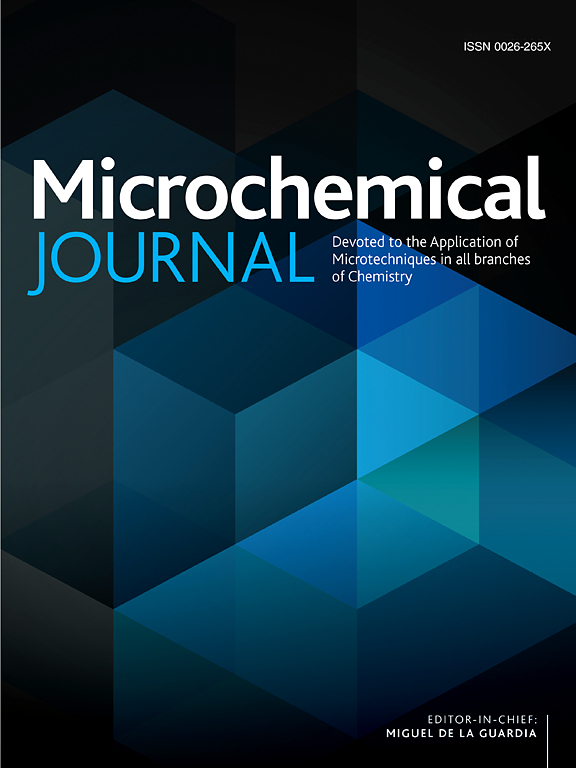Magnetic molecular imprinting-restricted access materials combined with luminous boric acid carbon dots for fluorescence monitoring of Tetracycline
IF 4.9
2区 化学
Q1 CHEMISTRY, ANALYTICAL
引用次数: 0
Abstract
In biological samples, the accurate fluorescence detection of tetracycline (TC) affects by not only the interfering molecules but also the nonspecific adsorption of marcromolecules such as proteins. This study developed magnetic molecular imprinting–restricted access materials (MMIP–RAMs) for TC detection. The MMIP–RAMs was synthesized using magnetic poly(chloromethylstyrene-co-divinylbenzene) (Fe3O4@PVBC/DVB) microspheres as the substrate, through two-step surface initiated-atom radical polymerization, TC-molecular imprinting polymers as the recognition sites and zwitterionic phosphorylcholine (MPC) polymers as the anti-protein sites were successively constructed onto Fe3O4@PVBC/DVB surface. The resulting MMIP–RAMs of Fe3O4@PVBC/DVB@MIP@poly(MPC) exhibited a high TC adsorption capacity (138.6 mg g−1) and an anti-protein capacity (above 96.8 %). Meanwhile, boric acid-containing carbon dots (BA-CDs) were prepared by citric acid and 3-aminobenzeneboronic acid precursors through hydrothermal method. In fluorescence detection, MMIP–RAMs could specially recognize TC by its imprinted cavity, after adding luminous BA-CDs, the combined MMIP–RAMs/TC could further bond BA-CDs with aid of boron affinity forces between cis-diol in TC and the boric acid groups in BA-CDs, forming MMIP–RAMs/TC/BA-CDs sandwich particles. The changes of pristine and remaining fluorescence intensity of BA-CDs had a linear relationship to TC content, establishing a simple fluorescence detection method. The fluorescence detection of TC was in the range of 44 − 264 ng mL−1 and low detection limit of 7.1 ng mL−1. When applying this method in milk, the fluorescence interference of background protein was completely eliminated by MMIP–RAMs to guarantee the accuracy of fluorescence determination, the resulting recovery rates of TC in milk were 100.0 − 105.4 % with relative standard deviations of 4.8 − 7.9 %, highlight application potential.
磁性分子印迹-限制准入材料结合发光硼酸碳点用于四环素的荧光监测
在生物样品中,四环素的准确荧光检测不仅受干扰分子的影响,还受蛋白质等大分子的非特异性吸附的影响。本研究开发了用于TC检测的磁性分子印迹限制存取材料(MMIP-RAMs)。以磁性聚氯甲基苯乙烯-共二乙烯基苯(Fe3O4@PVBC/DVB)微球为底物,通过两步表面引发原子自由基聚合,将tc -分子印迹聚合物作为识别位点,将两性离子磷酸胆碱(MPC)聚合物作为抗蛋白位点,依次构建到Fe3O4@PVBC/DVB表面,合成了MMIP-RAMs。所得的Fe3O4@PVBC/DVB@MIP@poly(MPC) MMIP-RAMs具有较高的TC吸附能力(138.6 mg g−1)和抗蛋白能力(96.8%以上)。同时,以柠檬酸和3-氨基苯硼酸为前驱体,采用水热法制备了含硼酸碳点(BA-CDs)。在荧光检测中,MMIP-RAMs可以通过其印迹空腔特异性识别TC,加入发光BA-CDs后,组合MMIP-RAMs /TC可以进一步利用TC中的顺式二醇与BA-CDs中的硼酸基团之间的硼亲合力将BA-CDs键合,形成MMIP-RAMs /TC/BA-CDs三明治颗粒。BA-CDs的原始和剩余荧光强度变化与TC含量呈线性关系,建立了一种简便的荧光检测方法。TC的荧光检测范围为44 ~ 264 ng mL−1,低检出限为7.1 ng mL−1。将该方法应用于牛奶中,MMIP-RAMs完全消除了背景蛋白的荧光干扰,保证了荧光测定的准确性,所得牛奶中TC的回收率为100.0 ~ 105.4%,相对标准偏差为4.8 ~ 7.9%,具有较强的应用潜力。
本文章由计算机程序翻译,如有差异,请以英文原文为准。
求助全文
约1分钟内获得全文
求助全文
来源期刊

Microchemical Journal
化学-分析化学
CiteScore
8.70
自引率
8.30%
发文量
1131
审稿时长
1.9 months
期刊介绍:
The Microchemical Journal is a peer reviewed journal devoted to all aspects and phases of analytical chemistry and chemical analysis. The Microchemical Journal publishes articles which are at the forefront of modern analytical chemistry and cover innovations in the techniques to the finest possible limits. This includes fundamental aspects, instrumentation, new developments, innovative and novel methods and applications including environmental and clinical field.
Traditional classical analytical methods such as spectrophotometry and titrimetry as well as established instrumentation methods such as flame and graphite furnace atomic absorption spectrometry, gas chromatography, and modified glassy or carbon electrode electrochemical methods will be considered, provided they show significant improvements and novelty compared to the established methods.
 求助内容:
求助内容: 应助结果提醒方式:
应助结果提醒方式:


